Jobs to be Done. How to implement the framework
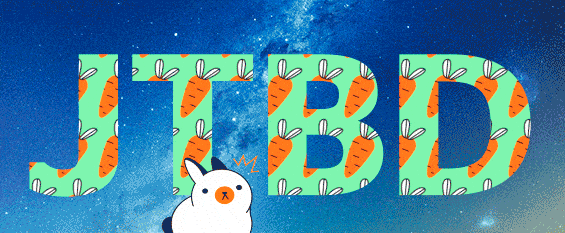
In our first Jobs to be Done article we tried to sort out the details of JTBD theory. What JTBD is, what it’s needed for, who it will be useful for, and what variations there are. You can read the first part first, this way it will be easier for you to navigate the theory and use it in practice.
Now, let’s see how you can implement JTBD. In this chapter, we’ll tell you about how to hold research based on the “Jobs” theory, how to define your goals, how to hold interviews, how to use frameworks, and how to figure out solutions.
Our article is based on the material by Dmitriy Kapaev, the co-founder of USEFUL. USEFUL agency makes customer research based on the “Jobs” theory. Dmitriy came to visit us and shared some awesome insights on JTBD, now we’re sharing them with you.
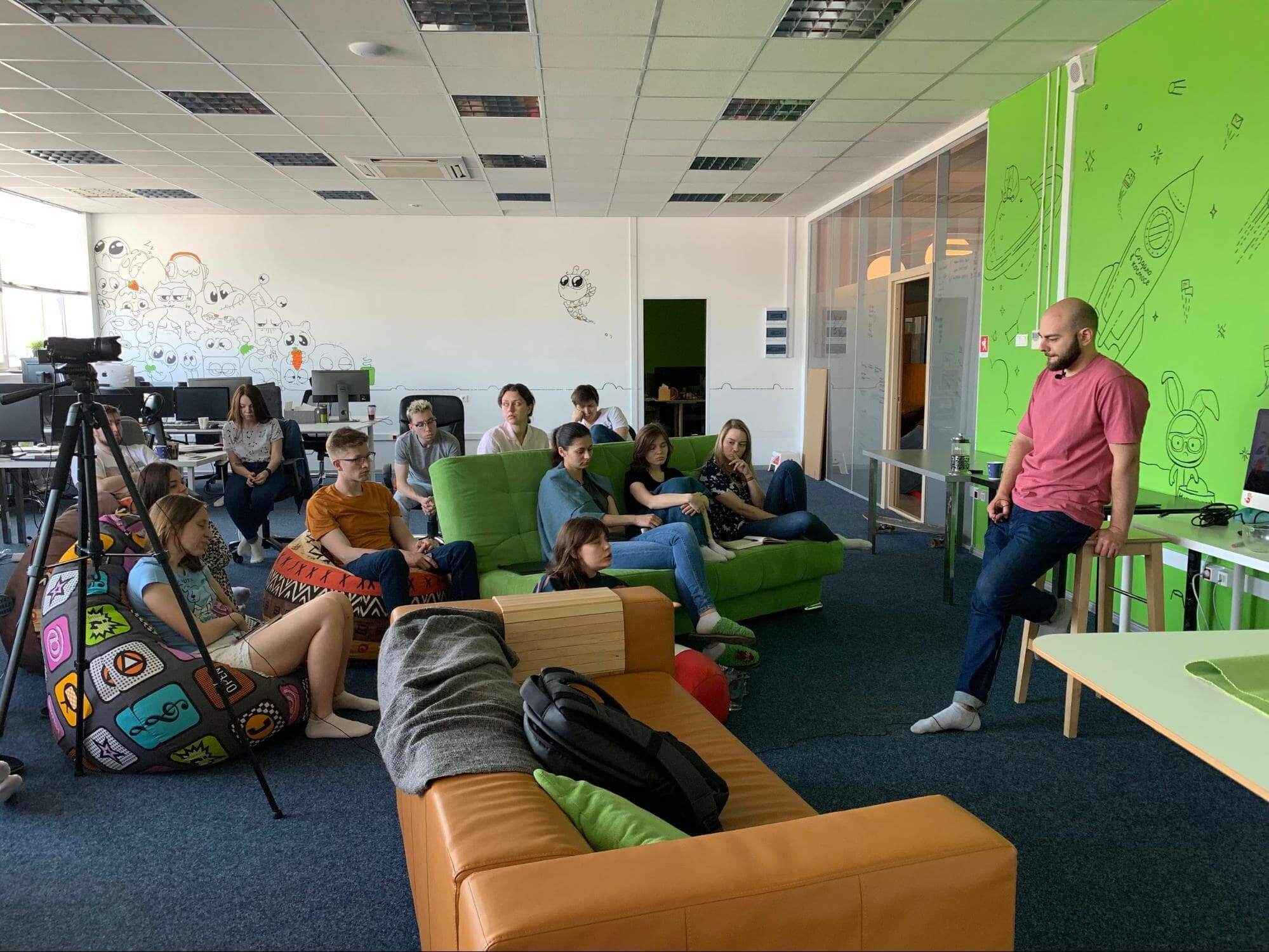
Let’s start, shall we!
JTBD research
What will the research look like, and what steps will it have?
Research steps:
- Define research goal. For starters, we have to find the goal of our research. What is it that we want to research and what we want to know as a result.
- Formulate job story hypotheses. On this step, we’ll need to define jobs based on our experience and the experience of our customers.
- Make interviews. Observing and gathering customer insights.
- Analyze data. Interpreting the data with frameworks.
- Create job stories. Formulating job stories based on the insights we’ve gathered.
- Think of solutions. Improving our product and correcting our strategy based on the information we’ve gathered.
Research goal
On this step of the research, we need to define what we want to find out with this research. Let’s say, we’re creating eco and animal-friendly cosmetics. So we only use natural ingredients, we don’t test our products on animals and we don’t use plastic packaging. All of our products have high demand, except for body creams. That means we have to find out why there is no demand for our body creams.
Along with the research goals, we need to define research questions:
- What jobs do our customers hire our body creams to do?
- Why do customers buy our body creams?
- Why don’t customers like our body creams?
After we’ve formulated our goal and research questions, we’re going to the next step.
Job story-driven hypotheses
In this step, we’ll need to formulate our job story-driven hypotheses, define our direct and indirect rivals and choose respondents for our interviews.
Defining rivals
- Other eco and animal friendly brands of cosmetics;
- non-eco, non-animal friendly brands of cosmetics;
- bloggers who produce their own cosmetics and share their recipes;
- soap making stores who sell ingredients for DIY cosmetics.
Formulating job story-driven hypotheses
Next, we’ll need to formulate hypotheses of job stories our customers may be hiring our product to do. These hypotheses may draw the portraits of the respondents we will be interviewing.
We’ll be formulating our hypotheses based on the job stories made and described by Intercom in their book, “Intercom on Jobs-to-be-Done”. The framework will be built into a sentence based on this template: “When <situation> I want to <motivation> so I can <outcome>”.
Situation — the description of the context our customer is facing their problem in. Motivation — the desired solution to the problem. Outcome – the process our customer wants to be going through in the future.
In our case, it’s not only the object of the customer’s desire that matters, it’s also the context of the situation that formed this desire.

Job story-driven hypotheses for eco and animal-friendly brand of cosmetics:
- I still want to look nice and healthy even when I’m minimizing my use of cosmetics packed in plastic.
- My skin is dull and dry, I want to get a product that will return my shining beauty.
Hypotheses on this step may still be pretty abstract because the research itself has not been done yet.
Defining customers
Once our hypotheses are formulated, we need to pick the right respondents for the interview. In our case, the right respondents are customers who have recently bought our product (body cream) or, again, have recently switched to a body cream of another brand (or the other way around).
For the interview, it’s better to pick customers who’d recently bought from you, because their memories and emotions of the purchase are still fresh.
Interview
We’ve defined our research goals, have formulated our hypotheses, and have found relevant respondents for the interview. Now we need to do the interview.
The key point of JTBD is the interview. We need to find out our customer’s issues and hidden needs. To be more precise, we need to know the reason behind “hiring” our solution.
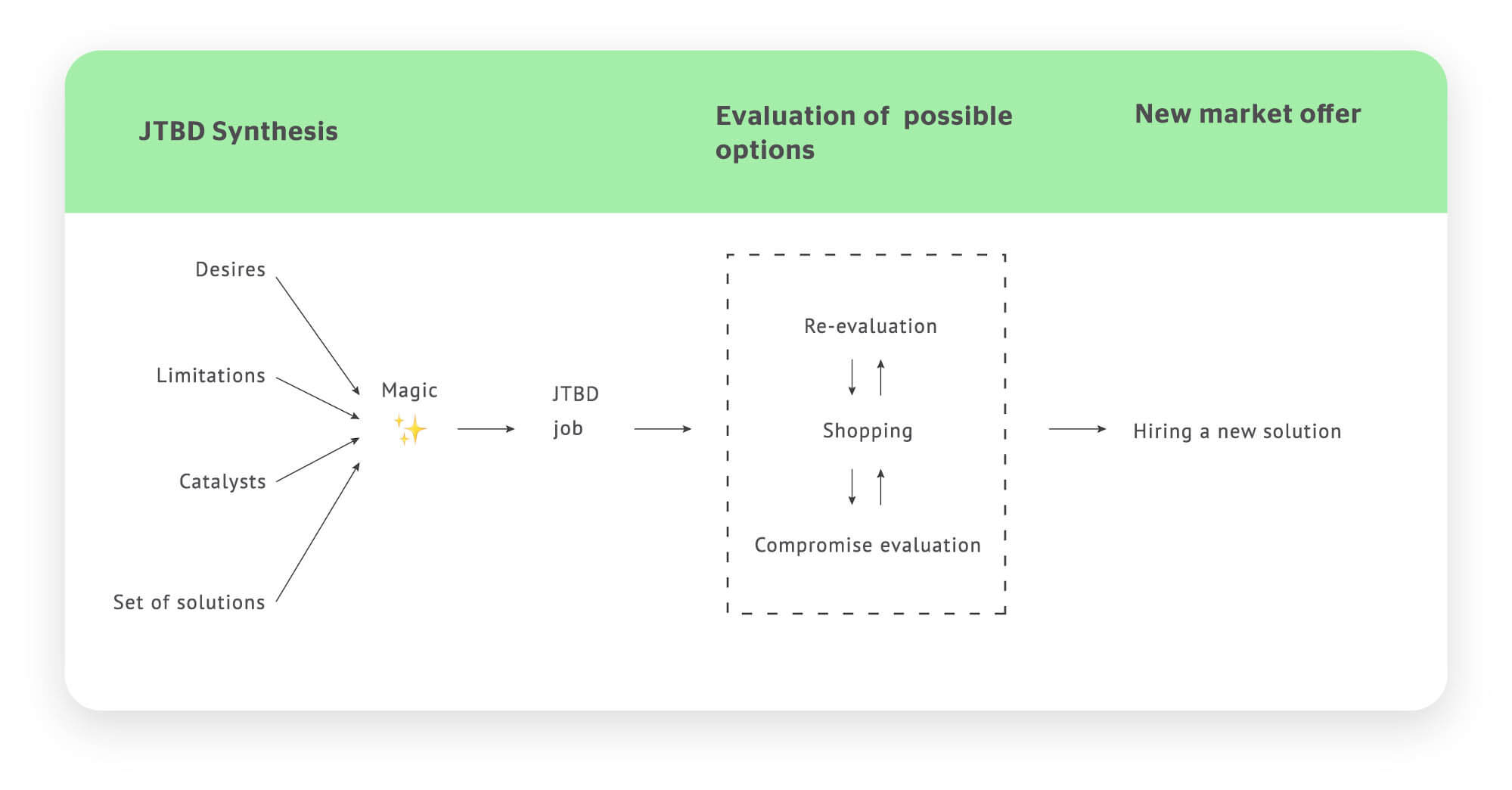
Remember Alan Klement’s framework from the first article. This model describes how jobs are created and how they get people to “hire” and “fire” products.
This interview must shed light on:
- Desires — future experience customer thinks of, but can’t currently get;
- Catalysts — events that made customer’s desires form;
- Limitations — obstacles on the way to making customer’s desires happen;
- Set of solutions — possible hiring variations that will let you make progress;
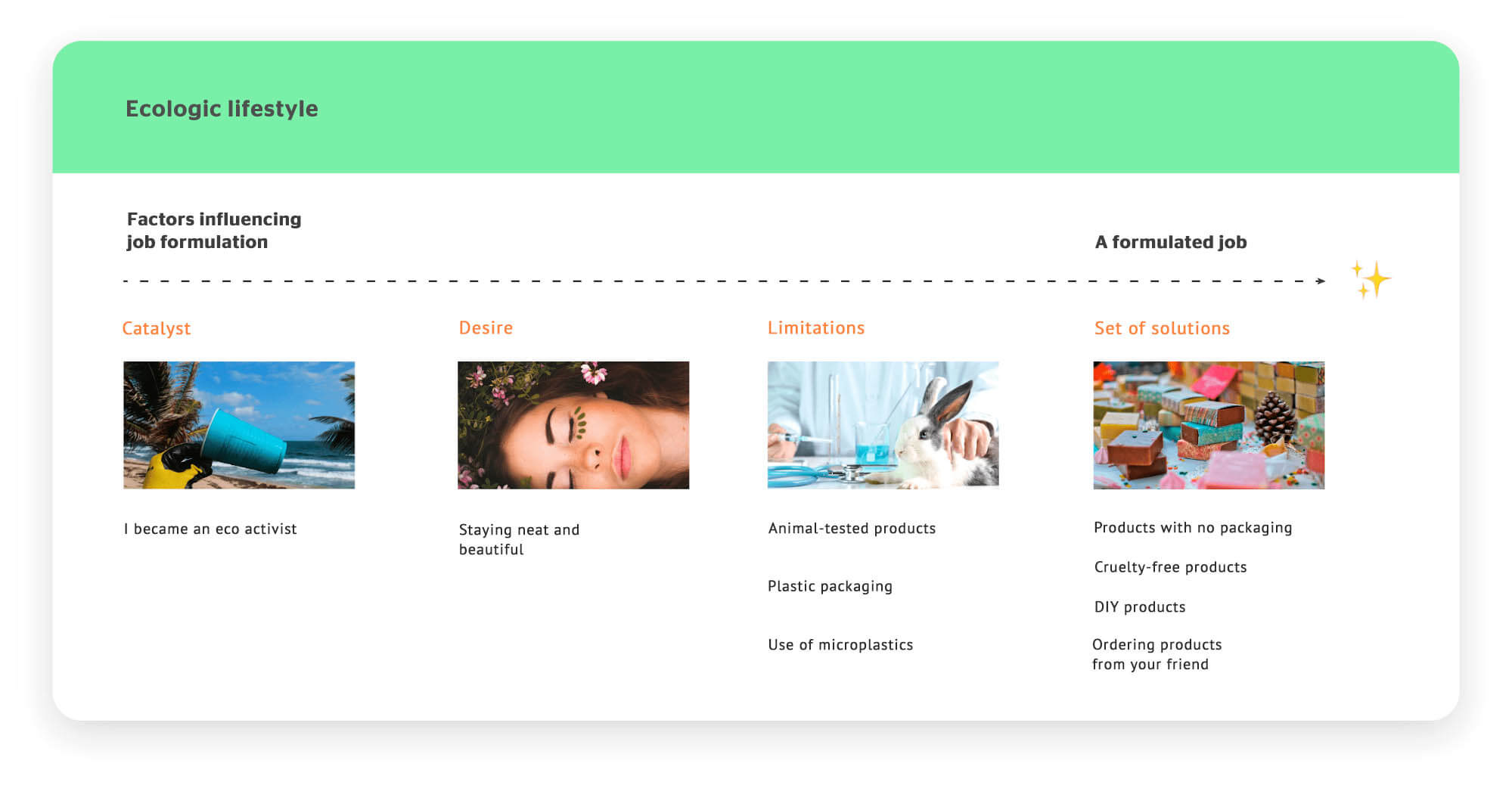
Remember, all of our interview questions must refer to the respondent’s past. We need to find out what has happened sometime in the past and how that lead to forming the job.
Take a look at this JTBD interview by Chris Spiek and Bob Moesta, where they’re interviewing a car buyer. It will let you understand the logic behind JTBD interviews and will help you gather your question pool.
We’ve made a list of general questions — JTBD questionnaire. These questions may help us make our interview. We’ll be updating our list based on our problems, products, and research goals. The keystone moments we have to define are desires, catalysts, limitations, and the set of solutions.
In our case, we need to find out why our body creams are not in demand.
Let’s roll then!
Desires
- Why have you decided to buy our body cream?
- What where your thoughts at the moment you were buying our body cream?
- What did you want our body cream to achieve for you?
Catalysts
- What was your reason behind buying our body cream?
- What made you buy our body cream?
- Where were you when you were buying our body cream?
- What was the weather at that moment?
- Was there anyone else with you then?
- How did you buy our body cream?
- Did you buy anything else?
Limitations
- What did you need our body cream for?
- Why wasn’t our body cream a good fit for you? Why did you decide to stop using it?
- What complications were you experiencing when buying our body cream?
Set of solutions
- Why did you choose our body cream?
- What other options were you considering aside from our body cream?
- What qualities were you paying most attention to, making the decision?
That’s what your list of questions will look like. It’s better to have two people conducting the interview, one will be asking questions and the other will be taking notes. You may also want to record the interview so you can listen through it and find subtler insights later.
One of our respondents was Brenda who’d recently bought our body cream and shampoo. In the interview, she told us that she was used to buying mass-market brands of body care, but has decided to lead an ecological lifestyle.
Brenda spent a lot of time looking for eco and animal-friendly cosmetics on the internet, she’d never found a fitting product and never discovered our brand either. Every option she’d found was either too expensive, had questionable quality, or had way too high a delivery cost.
Several days of fruitless searches later, Brenda turned her mind to the local market. She stumbled on us and purchased several of our products right away. Brenda liked our product, design, and brand concept. She bought our body cream because she’d recently run out of the one she had and her skin was very dry.
Read also:
👉 Live Chat Best Practices: 20 Hacks to Make Customer Service Better
👉7 Best Live Chat for eCommerce: Boost Conversion on your Website
👉 Top 5 live chat mobile app: find the best fit for your business
👉 Live Chat: How Online Chat Tool Can Help Your Business
👉 20 Best Live Chat Software for your website chat service
👉 Acquisition funnel marketing: Grow customer conversions at each step of user journey
👉 The top 15 inbound marketing tools: harness digital power and elevate your business
👉 10 best website personalization tools to deliver top-notch visitors experience
👉 7 best email capture tools: features and pricing compared for 2024
For her next purchase at our store, she’d taken the shampoo but decided not to take the body cream. We decided to find the reason why. Turns out she hasn’t used up the body cream yet. We were glad to hear out body cream was cost-effective.
Having spent some time talking with Brenda, we found that the reason why she hasn’t used up our product: the cream was too hard to apply due to its solid texture. So, because using our ecological body cream takes too much time for Brenda, she uses a body lotion her mother gave her.
10 similar interviews later, we ended up having a lot of precious information on our hands. What do we do next? Next, we listen through the interview records, analyze and interpret them. That’s where JTBD frameworks come in handy: they’ll help us set jobs, define contexts and figure out the struggle moments.
Data analysis
We’ll be analyzing and interpreting the information we’ve gathered using several frameworks.
“Progress Making Forces” by Chris Spiek and Bob Moesta
This diagram will let us find out what has led a customer to make a purchase, what their thoughts were at the moment of the purchase (Concept Of The New Way), and what past habits and anxieties of the new solution were holding them back.
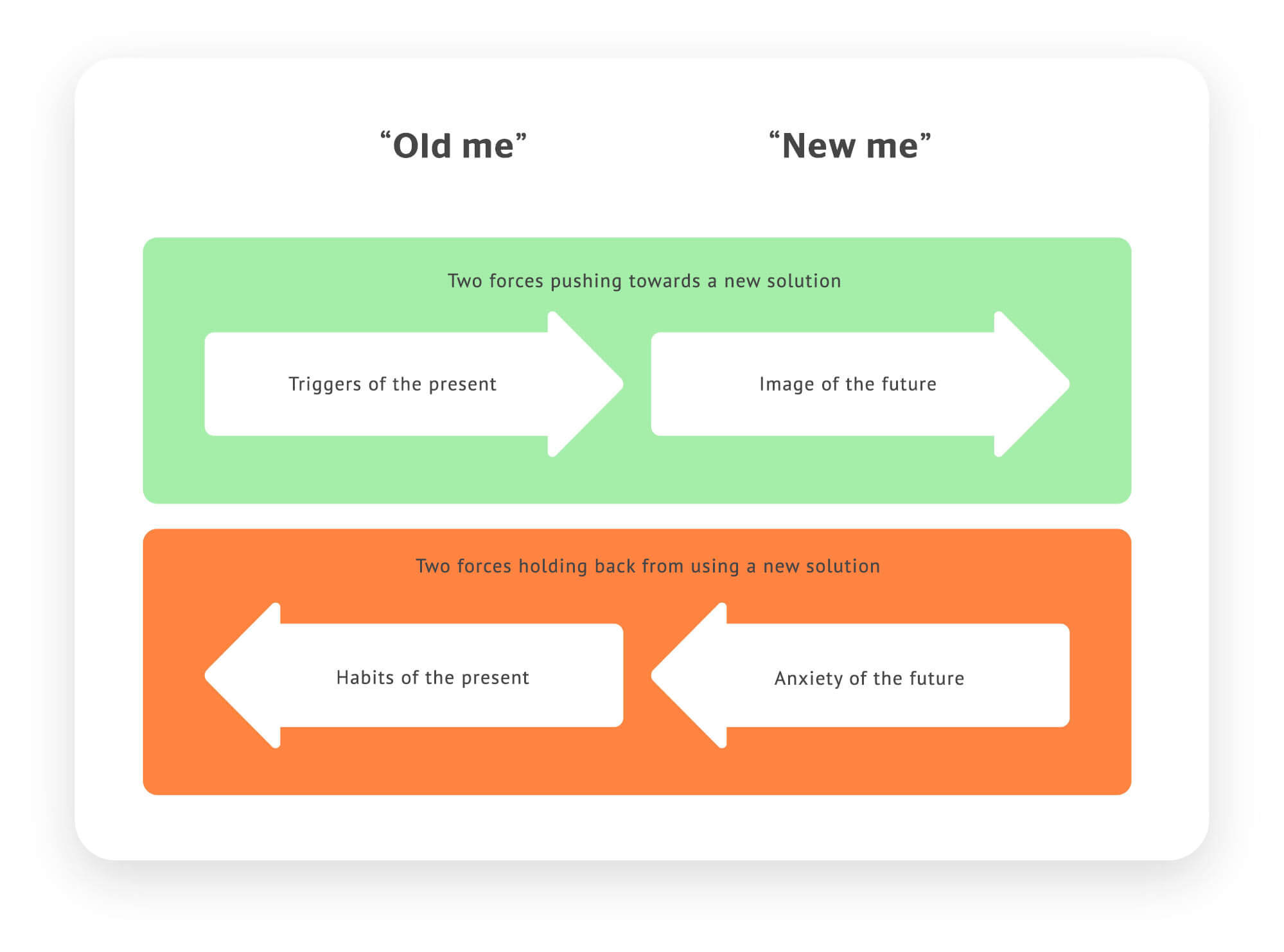
What was the push to making the decision to purchase? Brenda becoming an eco-activist.
What attracts Brenda to her new solution? Remaining neat and beautiful while still being ecologically friendly.
What’s holding Brenda back from changing her ways? Brenda’s very busy with work and studying, so she doesn’t have the time to check out all the eco shops. She doesn’t like purchasing online because she wants to try out her cosmetic products before she buys them.
What is Brenda worried about? She’s worried that the body cream has an unusual texture she’s never seen before in body creams, she’s afraid the cream might be of poor quality.
Now we understand what Brenda feels and what progress she wants to make. What’s next?
“Timeline” by Chris Spiek and Bob Moesta
Every item we buy follows the path from the first thought to being satisfied or disappointed with the new solution. If our new solution has disappointed us, we go through the path again.
A timeline will help us find out when our first decision to buy occurred, what’s happened in “event 1”, what’s initiated our proactive search, what’s happened in “event 2” when we decided to buy the product, and so on.
Knowing what was happening with our customers between the first thought to the moment of purchase is crucial.
Having held just one interview will leave you clueless about how to work with the data you’ve received. Once you’ve had 5 or 10 of them, however, you will start noticing certain similarities and behavioral patterns your customers share.

- First though. Brenda gets the idea of using eco-friendly cosmetics after finding out more about environmental pollution problems.
- Passive search. She started with reading articles and getting introduced to eco and animal friendly brands of cosmetics.
- Event 1 happened when Brenda has ran out of her shampoo and body cream, which made her actively search for new products on the internet. She didn’t find anything suiting her tastes so she started giving up on the idea.
- Event 2 happened when Brenda started searching her local market and bought a cosmetic product that was suiting all of her internal needs.
- Brenda started testing the products she’s bought. She liked the shampoo but the body cream was too hard to use.
- Now Brenda’s searching for a new eco-friendly body care product to “hire”.
Formulating our job story
The job story helps us understand the circumstances of the first thought of purchase occurring (i.e. understanding what was going on before a person started using our product).
After making the interview and analyzing all the information, we can formulate our respondents’ job stories.

Job story to a new eco-friendly lifestyle:
I worry about the environment, I want to follow all the rules of an ecological lifestyle to save nature.
I worry about the environment and lead an ecological lifestyle, and I still want to take care of my body and stay pretty.
Body cream job story:
My skin is dry and I can’t be buying simply any random cosmetics because I’m proactive towards the environment. I want to find an eco-friendly body care product, it must be affordable and easy to use so I can feel comfortable and caring about the environment.
Improving our existing product or creating a new one
Now we have a lot of job stories formulated. Next, we have to define contextual similarities and our respondents’ jobs, segment them and figure out what we can improve in the product.
There are two segmentation options: context-based and jobs-based segmentation. Segmenting by context fits when our respondents’ cases are similar. A lot of people face the same problems, but their desires are totally different. Segmenting by jobs can be used when respondents have different problems but their desired outcome is basically the same.
Once we’ve segmented our job stories, it’s time to analyze what improvements our product needs and move on to implementing them!
Read also:
👉 Live Chat Best Practices: 20 Hacks to Make Customer Service Better
👉7 Best Live Chat for eCommerce: Boost Conversion on your Website
👉 Top 5 live chat mobile app: find the best fit for your business
👉 Live Chat: How Online Chat Tool Can Help Your Business
👉 20 Best Live Chat Software for your website chat service
👉 Acquisition funnel marketing: Grow customer conversions at each step of user journey
👉 The top 15 inbound marketing tools: harness digital power and elevate your business
👉 10 best website personalization tools to deliver top-notch visitors experience
👉 7 best email capture tools: features and pricing compared for 2024


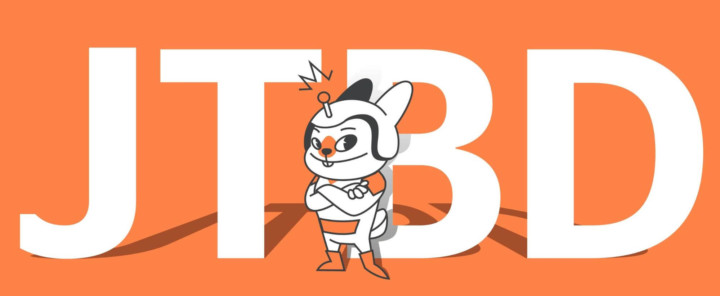

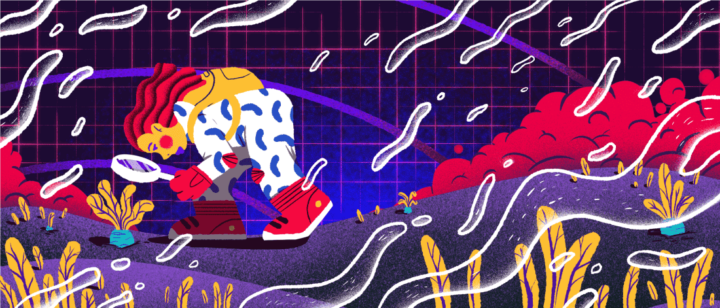
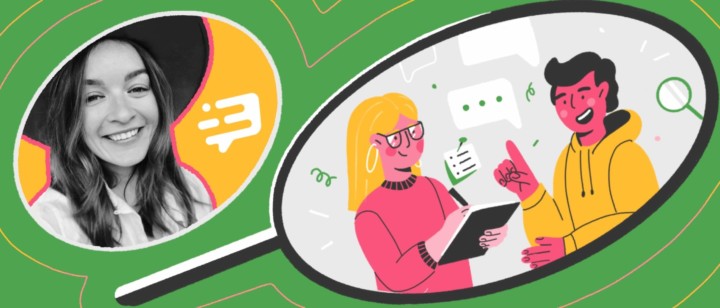
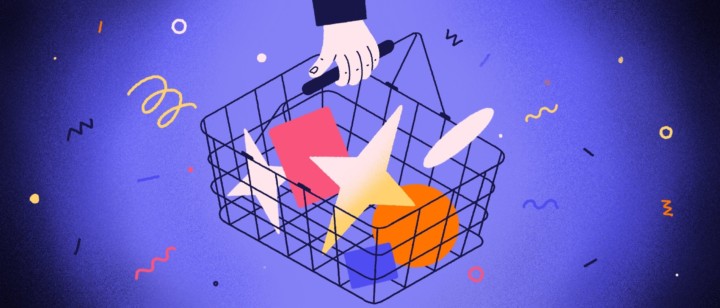
![4 steps as Chief Marketing Officer at a new company [Expert guide]](https://www.dashly.io/blog/wp-content/uploads/2022/10/4-steps-as-Chief-Marketing-Officer-at-a-new-company-Expert-guide-720x317.jpg)